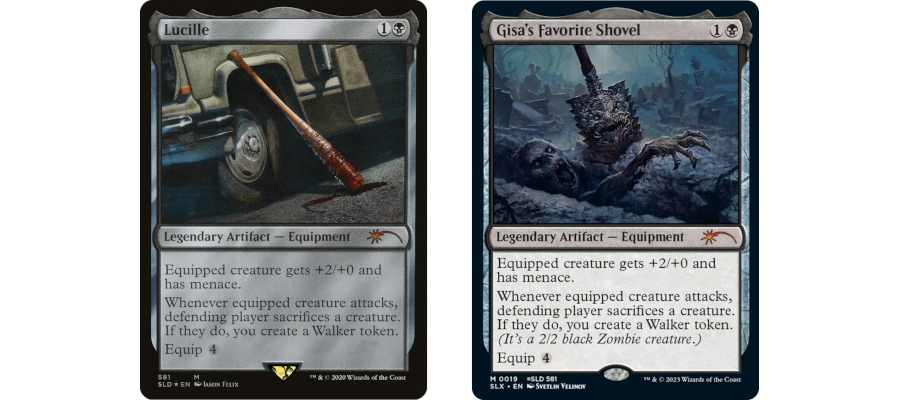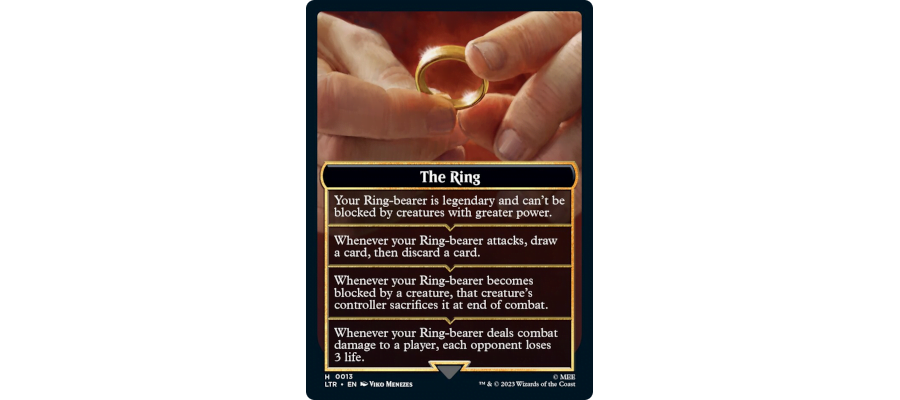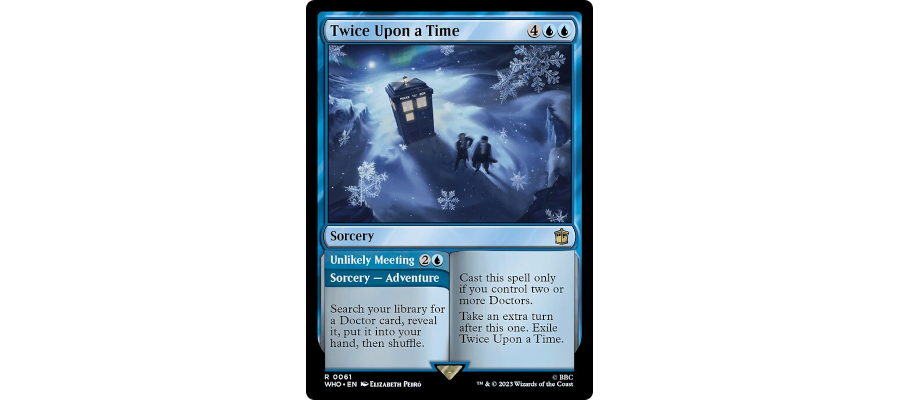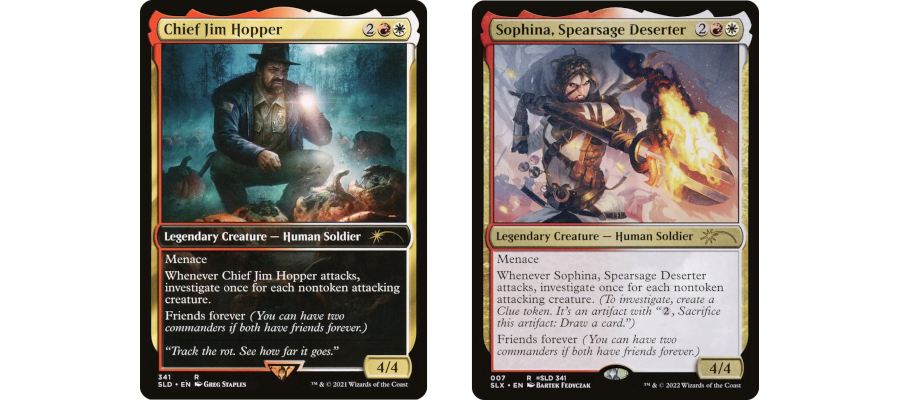I really like Universes Within. Not Universes Beyond, the system whereby Wizards of the Coast make cards using other people’s IPs, I’m very conflicted about that. Like the idea of it doesn’t bother me, I don’t think there’s a ‘purity’ of Magic to defend, Magic is a corporate product and anyone who wants you to think that it somehow is above these things thinks differently of the game than I do. It’s a game about faeries and elves and ripping off fantasy licenses, using licenses for real isn’t that big a deal.
Uh, but Universes Within is when they do that kind of thing and then come back to make a version of the card with their own specific Magic: The Gathering flavour that’s meant to fit on a Magic: The Gathering set world. I think that rules, and I’m looking forward to seeing more of it.
I also have come to think that I might never see another Universes Within product ever again.
A bit of history to frame this. When we got the original Universes Beyond cards of the Walking Dead (though they weren’t called that at the time), it was October 2020. These cards were original cards from The Walking Dead, which were legacy playable, available in limited supply and for a limited period of time. These cards were the source of a lot of controversy, which I didn’t feel particularly strongly about at the time. My basic take at the time is that Legacy is an ocean of piss, into which pissing does not dilute much at all, and I say that as someone who likes Legacy. If a card is a problem, it’s not like Legacy’s price barrier is meaningfully made worse by another hard to get card, and people should just play with proxies anyway. I mean did I say that? because I mean it now, that’s for sure. Point is, Walking Dead was followed then by Stranger Things and Street Fighter, little secret-lair drops of about ten to fifteen cards.
An important detail here is that in this context, there were three franchises, three secret lair products, and in total there were 23 cards. These cards were released in other sets, as part of a bonus list of cards that show up in ordinary boosters. This put some of them out there but it didn’t just replace the original versions and change their value. The relationship of Wizards of the Coast to their secondary market is a positively space-warping kind of conversation, which always needs to accept some nonsense because a lot of the criticism is bad faith and badly made and mostly involves comparing Wizards to even worse actors in similar spaces. When I talk about these cards being made available, I’m just trying to describe the scale of what Wizards did and how they did it.
As a side story here, in Ikoria, we got cards that could show up in boosters that were Godzilla-themed reskins of existing cards, with a little name tag that showed what their real name was with a new flavour, art, and pseudonym to turn it from, say, Zilortha, to Godzilla. I liked these a lot, I thought these kicked ass, but anyway. These were existing cards in sets that had two versions from the jump (except Godzilla until recently), and they were a way to get fun cool different versions of cards, and introduced the idea that these ‘official proxies’ that transformed a card into some cool tie-in or other franchise was an option. That’s cool.
Point is, they gave us 23 cards that didn’t fit Magic, then promised they would, eventually, release versions that did fit Magic, and that way, players who liked the cards but didn’t like the flavour of them had access to these cards. They could show up in other sets, as a slow drip of cards and that lined up okay with a small pool of cards they were updating.
There are 289 cards in the Lord of the Ring set. To make versions of these cards that are from and fit in the Magic: The Gathering franchise’s existing flavour and lore, you would need forty sets trickling out a few cards at a time. At the current release schedule, jokes aside, that would take ten years for Lord of the Rings.
To be fair to Lord of the Rings though, it’s not like they’d need to do all 289 cards. A lot of them are generic, kind of. I suppose I need to explain what I mean by ‘generic’ though. Many cards, almost all the cards, in the Lord of the Rings set are doing a lot to stretch the Magic rules over what people are pretty sure they kinda vaguely remember The Lord of The Rings has in it, especially filtered through the prominence of the movies. That means that there are a lot of cards that are there that, realistically speaking, aren’t really actually representing anything as much as they are wearing a name or a flavour text quote that’s there to remind you what they relate to. They also want you to buy them, so the cards have to be good cards that, hopefully, evoke what they’re trying to sell you…
…but they don’t make sense. Just as an example, The Eastfarthing Farmer is a peasant with a stick who’s meant to be a farmer from a place that has not known war and avoids conflict and conquest entirely, and he’s a better fighter than a trained soldier. A single Nazgul was a terrifying monster that rendered the Hobbits immensely scared, but an actual Nazgul without access to the ring is just a 1/2. You can just throw some rocks at that and get them to fuck off. The card is great, the card does an amazing job of being an interesting play experience, mind you, but it doesn’t fit the Nazgul in the books or movies. In this, there are a number of Lord of the Rings cards that are just generic Magic cards, with generic effects, that are then tied to the Lord of the Rings through the artwork and flavour text (two things mutable from card to card) and card type and name (two things not mutable from card to card).
The hardest thing in Lord of the Rings to retheme is the mechanics around the One Ring, which, fortunately, the card ‘The One Ring’ has nothing to do with. It’s just a really powerful card draw card – it could even just be themed around an existing object that exists in the Magic: The Gathering canon, the Bloodletter Quill used by Lazav. Heck, Circu’s could be the Palintir. But even then I’m just wasting my energy trying to fix a minor problem that shouldn’t be a problem but always will be, because Lord of the Rings is now inextricably linked with a bunch of cards anyone will want to play because of how good they are. The issue is the ring tempts you.
The funniest thing is, because the ring tempts you is so bad at conveying the problem of The One Ring in The Lord of the Rings it’s pretty easy to retheme. It’s just an adventure – it’s an adventure that elevates someone to a new position but also rewards them for being sneaky and teaches them things in desperate situations while it pushes the game to the end state. Easy. That doesn’t seem impossible to recreate in a Universes Within way. Skulk says Innistrad, but the whole affair could be a Trial from Amonkhet or whatever.
There are 56 cards with The Ring Tempts You or Ring-Bearer on them.
That’s 56 cards they’d have to redo entirely for the appeal and interest of players like me. Sure, they’ll have enough slush art for that eventually, but there’s always a use for slush art. And then they’ll have to find some place to print that many cards just for someone like me, who wants to play with the mechanic but despises the previous execution. Not only that, but some of the cards that do that are mainstream and very significant cultural signifiers, so you’d have to be, in a broad sense, very silly to consider it worth it to not be Frodo Baggins.
It’s very hard to imagine that being a thing.
The problems present in Lord of the Rings can be kind of routed around. Like, it’s not like Arwen is a meaningful character in The Lord of The Rings so her legendary card doesn’t do much to demand attention in the game. Sure, it’s a legendary elf, she can live along with Gwenna, A Person People Definitely Know And Care About. But Lord of the Rings is generic fantasy – like, literally, it helped to define the genre – and Dr Who is…
Dr Who is fucking nonsense.
Dr Who has ‘alien’ as a creature type. It represents multiple different creatures from multiple different worlds, as a catch-all type that recenters the entire universe as the world of humans and the world of aliens, where whole cultures only exist for one appearance in one story and don’t have a meaningful existence of their own. Dr Who has the first two-word creature type in Magic: The Gathering, something they’ve said doesn’t count and won’t be done on any in-universe versions. And then, above all else, Doctor Who has the absolute brain wrinkler that is Doctor’s Companion.
If you’re not aware there’s a mechanic on some cards called Doctor’s Companion. In the context of Dr Who, this is pretty sensible and makes some degree of obvious sense. If you want to play a commander deck headed up by one of the Doctors and a Doctor’s companion, you can; they’ll both sit in your command zone and you can play them as you would any given partners. Your deck gets to have all the colours of both cards. This is a good mechanic for enabling deckbuilding and flavour appropriate to the world they’re from. After all, all those cards are the Doctor, and he travels through time – they I guess – and their companions might meet them at different times. Easy.
Now try and translate that idea to any other mechanical framing.
Bear in mind it’s very specific; it’s not just ‘you can have a Time Lord as your second commander,’ it’s got to be a creature whose creature types are Time Lord Doctor only, so no fun with Morphoron. This is going to cover 42 cards, 15 of whom are Doctors, and 27 cards which are companions, and you need to have a narrative fiction that explains why all of these legendary characters associate the way they do, but always in an A+B combo but never a B+B combo.
And by the way, don’t look to the existing cards for reasons that makes sense, because it won’t show up on the cards. You have to know these characters from another source, because the cards aren’t going to tell you why and what they care about.
I love Universes Within because it’s a fanfiction puzzle of trying to find a place for an impossible piece. But with that love of seeing the things I like show up there’s the dark mirror of just how much I’ve realised I hate Universes Beyond. Not on principle – the idea is sound, and you might notice I haven’t remarked on the fairly anodyne, easily separated Warhammer 40k cards. I hate Universes Beyond not because it’s some kind of bad trend or bad imperative – evidence indicates it’s very commercially successful after all – but I hate it because so far they’ve used it for two major full-scale product releases and I think both those releases suck shit and make their franchises look stupid and bad.
As someone who isn’t part of the Dr Who fandom, I can’t imagine these cards exciting me to learn more. I find myself actively resistant, like these cards make these characters look awful. There’s a bunch of cards that have the extensive flavour of ‘a guy’, like Wilfred Mott and Adric and Ace and Graham O’Brien. Their flavour text is contextless mush, stuff like ‘I always come prepared’ and ‘wicked!’ and ‘Anyway, nothing to do with you surprises me any more, Doctor.’ One of those cards doesn’t have that flavour text and I bet you could tell me if you were a big fan but please understand how meaninglessly similar that kind of talk is. It’s like Secret Lair: Joss Whedon.
Look, here’s an example. The Eleventh Doctor, a man who looks like he could be defeated by a thrown cup of tea that doesn’t even have to hit him, has a mechanic that triggers on successfully dealing combat damage to an oponent, sneaking past defenses and, once he’s dealt damage, sets up a card from your hand to come into play later, for free. It’s probably best used with really cheap spells, suggesting a weenie swarm strategy or a lot of cantrips. And we get flavour words to indicate what this character’s about, how they’re doing what they’re doing.
It’s the words “I. AM. TALKING!” in full caps. Like it’s a shouted oath. Like it’s someone interrupting someone daring to interrupt him in the middle of some plan or some powerful speech or something.
Now.
I bet if you’re a Doctor Who fan, that moment that phrase evokes for you is badass. It’s probably really cool. But to me, it looks like someone took a famous moment of this character, jammed it onto a card that has nothing to do with it, and put flavour text on there so you would mark out.
Sometimes it’s a function of how complicated the cards are. There’s a lot of text on them and they have art, name, and flavour text that’s meant to inspire you to engage with what the card is. They don’t. And don’t say ‘oh no, no, the flavour here is really good if you know about this thing from the show that sucks,’ because these cards aren’t here to get me to know about things. They’re here to reward me for already knowing them. This is your fandom showing off in my space and trying to look as cool as possible and I think it looks like it sucks.
These are the worst kind of fandom detritus.
They are Funko Pop Magic cards.
They are Certificates of Fandom Investment.
And I will probably never get to see a version of these things made to the standards of Magic: The Gathering to which I had become accustomed.




